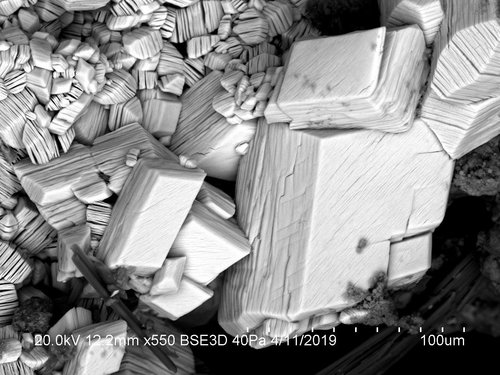Strassmannite
A valid IMA mineral species
This page is currently not sponsored. Click here to sponsor this page.
About Strassmannite
Formula:
Al(UO2)(SO4)2F · 16H2O
Colour:
Light yellow–green
Hardness:
1½
Specific Gravity:
2.20
Crystal System:
Monoclinic
Name:
Named for Friedrich Wilhelm (Fritz) Straßmann (22 February 1902, Boppard, German Empire – 22 April 1980, Mainz, West Germany), chemist who worked with Otto Hahn and Lise Meitner on the discovery of nuclear fission (of uranium) in 1938, for which he received the 1944 Nobel Prize for Chemistry. He served as Director of the Max Planck Institute for Chemistry and later founded the Institute of Nuclear Chemistry. In 1989, the International Astronomical Union named an asteroid for him, 19136 Straßmann.
Name changed in 2024 (IMA Newsletter 77) from straßmannite to strassmanite.
Name changed in 2024 (IMA Newsletter 77) from straßmannite to strassmanite.
Structurally related to leydetite, magnesioleydetite and wetherillite. Unique combination of elements (at the upload time).
A higher-hydrate counterpart of gurzhiite.
A higher-hydrate counterpart of gurzhiite.
Unique Identifiers
Mindat ID:
52751
Long-form identifier:
mindat:1:1:52751:2
GUID
(UUID V4):
(UUID V4):
3786e109-c773-426c-b9fc-6b22fe759607
IMA Classification of Strassmannite
Approved
Approval year:
2017
First published:
2019
Approval history:
IMA No. 2017-086
Named changed in 2024 (IMA Newsletter 77):
"It was agreed to modify the name straßmannite to strassmannite, with “double s” instead of ß – the so-called “Eszett” which is peculiar of the German alphabet. This is in keeping with a recent CNMNC resolution [Mineralogical Magazine, 87, 225-232 (2023)] which aims at rationalising the mineralogical nomenclature by abolishing Greek letters as well as Arabic and Roman numerals from mineral names. Straßmannite represented the unique case among mineral names in which the Eszett was employed instead of double s. Therefore, for the sake of analogy with fleisstalite, giessenite, günterblassite, mössbauerite, phosphorrösslerite and rösslerite, the mineral straßmannite – which was approved only six years ago – is now renamed strassmannite. This is an executive decision taken by the CNMNC officers."
Named changed in 2024 (IMA Newsletter 77):
"It was agreed to modify the name straßmannite to strassmannite, with “double s” instead of ß – the so-called “Eszett” which is peculiar of the German alphabet. This is in keeping with a recent CNMNC resolution [Mineralogical Magazine, 87, 225-232 (2023)] which aims at rationalising the mineralogical nomenclature by abolishing Greek letters as well as Arabic and Roman numerals from mineral names. Straßmannite represented the unique case among mineral names in which the Eszett was employed instead of double s. Therefore, for the sake of analogy with fleisstalite, giessenite, günterblassite, mössbauerite, phosphorrösslerite and rösslerite, the mineral straßmannite – which was approved only six years ago – is now renamed strassmannite. This is an executive decision taken by the CNMNC officers."
Classification of Strassmannite
7.EB.15
7 : SULFATES (selenates, tellurates, chromates, molybdates, wolframates)
E : Uranyl sulfates
B : With medium-sized cations
7 : SULFATES (selenates, tellurates, chromates, molybdates, wolframates)
E : Uranyl sulfates
B : With medium-sized cations
Mineral Symbols
As of 2021 there are now IMA–CNMNC approved mineral symbols (abbreviations) for each mineral species, useful for tables and diagrams.
| Symbol | Source | Reference |
|---|---|---|
| Sßm | IMA–CNMNC | Warr, L.N. (2021). IMA–CNMNC approved mineral symbols. Mineralogical Magazine, 85(3), 291-320. doi:10.1180/mgm.2021.43 |
Physical Properties of Strassmannite
Colour:
Light yellow–green
Streak:
Nearly white
Hardness:
1½ on Mohs scale
Tenacity:
Brittle
Cleavage:
Distinct/Good
On {001}
On {001}
Fracture:
Irregular/Uneven
Density:
2.20(2) g/cm3 (Measured) 2.179 g/cm3 (Calculated)
Comment:
Flotation in a mixture of methylene iodide and toluene; calculated value is for ideal formula
Optical Data of Strassmannite
Type:
Biaxial (-)
RI values:
nα = 1.477(2) nβ = 1.485(2) nγ = 1.489(2)
2V:
Measured: 70° (2), Calculated: 70.2°
Max Birefringence:
δ = 0.012

Image shows birefringence interference colour range (at 30µm thickness)
and does not take into account mineral colouration.
and does not take into account mineral colouration.
Surface Relief:
Moderate
Dispersion:
slight, r>v
Optical Extinction:
Y = b, X ∧ c = 20° in the obtuse angle β.
Pleochroism:
Visible
Comments:
X = nearly colourless, Y = pale green–yellow, Z = light green–yellow
Comments:
Absorption: X < Y < Z.
Chemistry of Strassmannite
Mindat Formula:
Al(UO2)(SO4)2F · 16H2O
Crystallography of Strassmannite
Crystal System:
Monoclinic
Class (H-M):
2/m - Prismatic
Space Group:
B2/b
Setting:
C2/c
Cell Parameters:
a = 11.0187(5) Å, b = 8.3284(3) Å, c = 26.673(2) Å
β = 97.426°
β = 97.426°
Ratio:
a:b:c = 1.323 : 1 : 3.203
Unit Cell V:
2,427.20 ų (Calculated from Unit Cell)
X-Ray Powder Diffraction
Powder Diffraction Data:
| d-spacing | Intensity |
|---|---|
| 13.24 Å | (100) |
| 6.61 Å | (53) |
| 6.11 Å | (26) |
| 5.74 Å | (35) |
| 4.494 Å | (22) |
| 3.324 Å | (38) |
| 3.265 Å | (20) |
| 3.138 Å | (23) |
Geological Environment
Paragenetic Mode(s):
| Paragenetic Mode | Earliest Age (Ga) |
|---|---|
| Stage 7: Great Oxidation Event | <2.4 |
| 47a : [Near-surface hydration of prior minerals] | |
| 47b : [Sulfates and sulfites] | |
| 47f : [Uranyl (U⁶⁺) minerals] |
Type Occurrence of Strassmannite
Co-Type Localities:
General Appearance of Type Material:
Equant crystals to 0.2 mm in irregular aggregates to ∼0.5 mm across.
Place of Conservation of Type Material:
Mineralogical collections of the Natural History Museum of Los Angeles County, 900 Exposition Boulevard, Los Angeles, CA 90007, USA, catalogue numbers 67264 (GL), 67265 (GL), 67266 (M), and 67267 (M) (cotypes).
Geological Setting of Type Material:
Efflorescent mineral, formed in the humid underground workings of an abandoned mine in a sandstone-hosted uranium deposit.
Associated Minerals at Type Locality:
Reference:
Kampf, A.R., Plášil, J., Kasatkin, A.V., Nash, B.P. and Marty, J. (2019) Magnesioleydetite and straβmannite, two new uranyl sulfate minerals with sheet structures from Red Canyon, Utah. Mineralogical Magazine: 83(3): 349-360.
Synonyms of Strassmannite
Common Associates
Associated Minerals Based on Photo Data:
| 1 photo of Strassmannite associated with Magnesioleydetite | Mg(UO2)(SO4)2 · 11H2O |
Related Minerals - Strunz-mindat Grouping
| 7.EB. | Bobcookite | NaAl(UO2)2(SO4)4 · 18H2O |
| 7.EB. | Alwilkinsite-(Y) | Y(UO2)3(SO4)2O(OH)3(H2O)7 · 7H2O |
| 7.EB. | Gurzhiite | Al(UO2)(SO4)2F · 10H2O |
| 7.EB.I | Shinarumpite | [Co(H2O)6][(UO2)(SO4)2(H2O)] · 4H2O |
| 7.EB. | Zincorietveldite | Zn(UO2)(SO4)2(H2O)5 |
| 7.EB. | Chenowethite | Mg(H2O)6[(UO2)2(SO4)2(OH)2] · 5H2O |
| 7.EB.05 | Johannite | Cu(UO2)2(SO4)2(OH)2 · 8H2O |
| 7.EB.05 | Meitnerite | (NH4)(UO2)(SO4)(OH) · 2H2O |
| 7.EB.10 | Deliensite | Fe[(UO2)2(SO4)2(OH)2](H2O)7 |
| 7.EB.10 | Rietveldite | Fe(UO2)(SO4)2(H2O)5 |
| 7.EB.15 | Leydetite | Fe(UO2)(SO4)2 · 11H2O |
| 7.EB.15 | Magnesioleydetite | Mg(UO2)(SO4)2 · 11H2O |
| 7.EB.20 | Greenlizardite | (NH4)Na(UO2)2(SO4)2(OH)2 · 4H2O |
| 7.EB.25 | Markcooperite | Pb2(UO2)(TeO6) |
Fluorescence of Strassmannite
Bright greenish-blue fluorescence with 405 nm excitation
Other Information
Notes:
Easily soluble in room-temperature H2O.
Health Risks:
No information on health risks for this material has been entered into the database. You should always treat mineral specimens with care.
Internet Links for Strassmannite
mindat.org URL:
https://www.mindat.org/min-52751.html
Please feel free to link to this page.
Please feel free to link to this page.
Search Engines:
External Links:
Mineral Dealers:
References for Strassmannite
Reference List:
Hålenius, U., Hatert, F., Pasero, M., Mills, S. J. (2018) IMA Commission on New Minerals, Nomenclature and Classification (CNMNC) Newsletter 41. European Journal of Mineralogy, 30. 183-186 doi:10.1127/ejm/2018/0030-2736p.184
Localities for Strassmannite
Locality List
 - This locality has map coordinates listed.
- This locality has map coordinates listed.
 - This locality has estimated coordinates.
ⓘ - Click for references and further information on this occurrence.
? - Indicates mineral may be doubtful at this locality.
- This locality has estimated coordinates.
ⓘ - Click for references and further information on this occurrence.
? - Indicates mineral may be doubtful at this locality.
 - Good crystals or important locality for species.
- Good crystals or important locality for species.
 - World class for species or very significant.
(TL) - Type Locality for a valid mineral species.
(FRL) - First Recorded Locality for everything else (eg varieties).
- World class for species or very significant.
(TL) - Type Locality for a valid mineral species.
(FRL) - First Recorded Locality for everything else (eg varieties).
All localities listed without proper references should be considered as questionable.
Germany | |
| Stolze et al. (04/2021) |
USA (TL) | |
| Hålenius et al. (2018) +1 other reference |
| Kampf et al. (2019) |
| EDS analyzed by Joy Desor. |
Quick NavTopAbout StrassmanniteUnique IdentifiersIMA Classification Classification Mineral SymbolsPhysical Properties Optical Data Chemistry Crystallography X-Ray Powder DiffractionGeological EnvironmentType Occurrence SynonymsCommon AssociatesStrunz-MindatFluorescence Other InformationInternet Links References Localities Locality List







 symbol to view information about a locality.
The
symbol to view information about a locality.
The 



Uranus Mine, Kleinrückerswalde, Annaberg-Buchholz, Erzgebirgskreis, Saxony, Germany